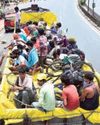
The first major urban settlement to be unearthed in India was Rajgir, or “Rajagriha” (abode of the king), in Bihar’s Nalanda district and it was assigned to the 6th century BCE. Rajgirwas excavated as early as 1905; since then, several excavations have been conducted and sites discovered around the region. Archaeologists confirmed that this was part of the Second Urbanisation Phase in India, the first being Mohenjo-daro and Harappa even though they were discovered only in 1924. Urban settlements are usually large and characterised by brick structures, industrial activity and water management, with agricultural and economic activities. A Second Urbanisation Phase situated in the southwas never considered a possibility. It is in this context that the excavations at Keeladi have provided a new window to historians.
In 2014, when the Archaeological Survey of India (ASI) was digging at Keeladi, the Tamil Nadu State Department of Archaeology (TNSDA) was excavating at Alagankulam, a port city of the Pandya kings located where the Vaigai river meets the Bay of Bengal.
The Alagankulam excavations were carried out for seven seasons (a season usually runs from October to September) and evidence of four distinct cultures was unearthed: 4th century BCE to 1st century CE,where black and red ware (BRW) were found; 1st century CE to 2nd century CE where rouletted ware, amphorae and Roman coins were unearthed; 2nd century CE to 4th century CE in which BRW, grey ware and a specially named Alagankulam Ware (ceramics are usually compared with similar typology and for this ware there was no comparison, hence the name) were found; and in the topmost layer, Chola coins and Chinese ware were unearthed.
Denne historien er fra October 25, 2019-utgaven av FRONTLINE.
Start din 7-dagers gratis prøveperiode på Magzter GOLD for å få tilgang til tusenvis av utvalgte premiumhistorier og 9000+ magasiner og aviser.
Allerede abonnent ? Logg på
Denne historien er fra October 25, 2019-utgaven av FRONTLINE.
Start din 7-dagers gratis prøveperiode på Magzter GOLD for å få tilgang til tusenvis av utvalgte premiumhistorier og 9000+ magasiner og aviser.
Allerede abonnent? Logg på

How Not To Handle An Epidemic
The lockdowns were meant to buy time to put in place appropriate health measures and contain the coronavirus’ spread, but they have failed to achieve the objective and heaped immense misery on the marginalised sections of society. India is still in the exponential phase of the COVID-19 infection and community transmission is a reality that the government refuses to accept.

Tragedy on foot
As the COVID-19-induced lockdown cuts the ground beneath their feet in Tamil Nadu, thousands of migrant workers are trudging along the highway to the relative safety of their upcountry homes.

Sarpanchs as game changers
Odisha manages to keep COVID-19 well under control because of the strong participation of panchayati raj institutions and the community at the grass-roots level under the leadership of Chief Minister Naveen Patnaik.

Scapegoating China
As the COVID-19 death rate spikes and the economy tanks in the United States, Donald Trump and his advisers target China and the World Health Organisation with an eye to winning the forthcoming presidential election.

New worries
Kerala’s measured approach to the pandemic and lockdown has yielded results. But it still has to grapple with their huge economic impact on its economy, which it feels the Centre’s special financial relief package does little to alleviate.
No love lost for labour
Taking advantage of the lockdown and the inability of workers to organise protests, many State governments introduce sweeping changes to labour laws to the detriment of workers on the pretext of reviving production and boosting the economy.

Capital's Malthusian moment
In a world that needs substantial reorienting of production and distribution, Indian capital is resorting to a militant form of moribund neoliberalism to overcome its current crisis. In this pursuit of profit, it is ready and willing to throw into mortal peril millions whom it adjudicates as not worth their means—an admixture of social Darwinism born of capital’s avarice and brutalism spawned by Hindutva. .

Understanding migration
When governments and their plans are found to be blatantly wanting in addressing reverse migration, exercises such as the Ekta Parishad’s survey of migrant workers throughout India can be useful to work out creative long-lasting solutions.

Waiting for Jabalpur moment
The Supreme Court’s role in ensuring executive accountability during the ongoing lockdown leaves much to be desired. Standing in shining contrast is the record of some High Courts.

An empty package
The Modi regime, which has been unable to control the COVID-19 infection, restore economic activity and provide relief to millions exposed to starvation, trains its sights on Indian democracy, making use of the panic generated by fear and a lockdown that forecloses paths of resistance.